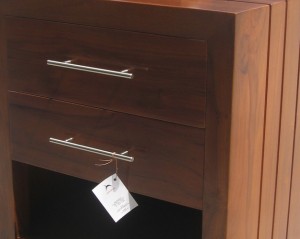Throughout history, there has been an appreciation for craftsmanship and attention to detail found in fine wood furniture, or casegoods as it is known in the furniture industry. Today, Canadian furniture makers unite the art of cabinetry with advanced technology, to create top-quality cabinets, buffets, dressers, wall systems, and chests for living rooms, dining rooms and bedrooms.

For example, the fine art of veneering has been revived and most wood furniture available on the market now, features veneer construction. Veneering typically consists of a number of wood layers, permanently bonded together in a sandwich.
Some people mistakenly equate veneering with inferior quality wood furniture, but in fact, case goods constructed with veneers are usually strong, durable, rich-looking and attractively priced. Many fine antiques, particularly those of the 18th century, were constructed with matched veneers of walnut, mulberry, yew and other burr woods, to create rich, striking effects. The most decorative type of veneered treatment is well known as marquetry – a process of laying veneers of contrasting light and dark-colored woods on to a solid base.
This technique, which sometimes includes inlays of mother-of-pearl or ivory, was widely used in 17th and 18th century England, to decorate the surfaces of clock cases, cabinets, chests of drawers, tables or mirror frames. Of course, in those days, veneers were thick and sawn by hand.
Modern technology permits the rotary cutting of ultra-thin sheets of veneer, which are permanently bonded together in as many as five layers, with high-intensity adhesives, which prevent peeling. The type of wood used in casegoods is important, whether the furniture is made of veneer, solid wood, or combination construction. Walnut, ash, cherry and redwood all make attractive veneers. From their irregular growth of fibres, a decorative grain pattern can be obtained. A crotch veneer, with its recognizable, y-shape, is obtained from forks in a tree trunk. Burl veneers, which are often used to highlight expanses such as the top of a dining-room table, feature the irregularities created by large wart-like growth on tree trunks.
Butt-wood veneers are taken from the root-stem connection of a tree, while bird’s-eye cuts are favored for the natural distortions in the grain, caused by depressions in the annual rings of the tree. Whatever the wood used, the quality check for veneered furniture is to look for matched graining patterns on the piece. Most casegoods are constructed from a combination of hardwoods (such as oak, walnut, mahogany, pecan, birch and maple) and softwoods (pine, spruce, fir and redwood).
Quality furniture is made from wood that has been kiln-dried to remove moisture and sap and therefore resists warping and twisting. Solid wood furniture is made from wood that is cut lengthwise into planks and glued into solid panels to increase stability and highlight the variations in grain.
For example, solid pine, which is used most often for colonial, country, and traditional styles, lends itself well to the carving and details of these styles. Other advantages of solid wood furniture include the fact that the tops and edges need only be sanded before finishing, and the surface cannot loosen or peel.
In addition, repairs to the surface of solid wood furniture allow for heavy sanding and refinishing. However, solid wood furniture may be expensive and unless the wood is well-conditioned, it may warp, shrink or swell with changes in humidity. To overcome this problem, solid wood table tops are usually made from matched glued boards, joined by tongue and grove or edge-glued joints.
Most high-quality furniture today offers the best of both worlds, in constructions that mix solid wood with veneers. Quality spotting of case goods includes a close look at the way the corners are joined. Pull out a drawer, and turn it on its side if necessary, to see if the dovetail or grooved joints are screwed, glued and doweled – all signs of high-quality furniture.
